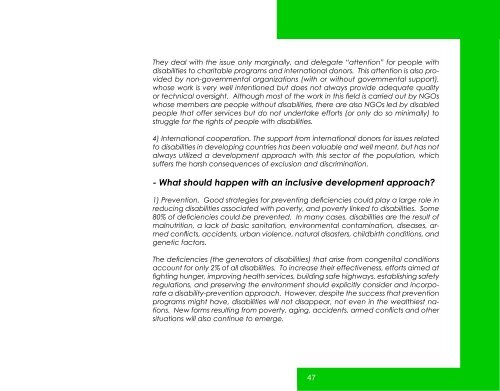in English - Handicap International
in English - Handicap International
in English - Handicap International
Create successful ePaper yourself
Turn your PDF publications into a flip-book with our unique Google optimized e-Paper software.
They deal with the issue only marg<strong>in</strong>ally, and delegate “attention” for people with<br />
disabilities to charitable programs and <strong>in</strong>ternational donors. This attention is also provided<br />
by non-governmental organizations (with or without governmental support),<br />
whose work is very well <strong>in</strong>tentioned but does not always provide adequate quality<br />
or technical oversight. Although most of the work <strong>in</strong> this field is carried out by NGOs<br />
whose members are people without disabilities, there are also NGOs led by disabled<br />
people that offer services but do not undertake efforts (or only do so m<strong>in</strong>imally) to<br />
struggle for the rights of people with disabilities.<br />
4) <strong>International</strong> cooperation. The support from <strong>in</strong>ternational donors for issues related<br />
to disabilities <strong>in</strong> develop<strong>in</strong>g countries has been valuable and well meant, but has not<br />
always utilized a development approach with this sector of the population, which<br />
suffers the harsh consequences of exclusion and discrim<strong>in</strong>ation.<br />
- What should happen with an <strong>in</strong>clusive development approach?<br />
1) Prevention. Good strategies for prevent<strong>in</strong>g deficiencies could play a large role <strong>in</strong><br />
reduc<strong>in</strong>g disabilities associated with poverty, and poverty l<strong>in</strong>ked to disabilities. Some<br />
80% of deficiencies could be prevented. In many cases, disabilities are the result of<br />
malnutrition, a lack of basic sanitation, environmental contam<strong>in</strong>ation, diseases, armed<br />
conflicts, accidents, urban violence, natural disasters, childbirth conditions, and<br />
genetic factors.<br />
The deficiencies (the generators of disabilities) that arise from congenital conditions<br />
account for only 2% of all disabilities. To <strong>in</strong>crease their effectiveness, efforts aimed at<br />
fight<strong>in</strong>g hunger, improv<strong>in</strong>g health services, build<strong>in</strong>g safe highways, establish<strong>in</strong>g safety<br />
regulations, and preserv<strong>in</strong>g the environment should explicitly consider and <strong>in</strong>corporate<br />
a disability-prevention approach. However, despite the success that prevention<br />
programs might have, disabilities will not disappear, not even <strong>in</strong> the wealthiest nations.<br />
New forms result<strong>in</strong>g from poverty, ag<strong>in</strong>g, accidents, armed conflicts and other<br />
situations will also cont<strong>in</strong>ue to emerge.<br />
47

















